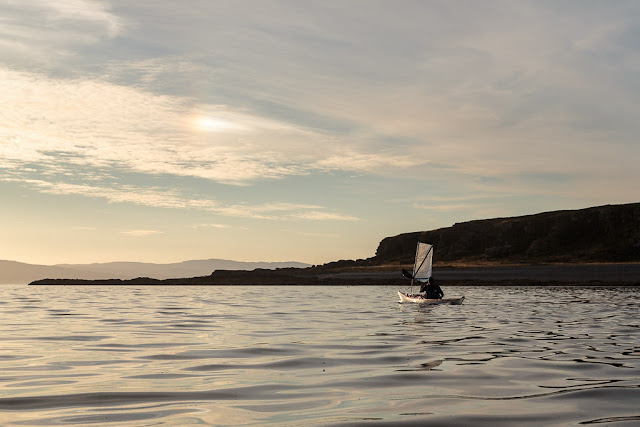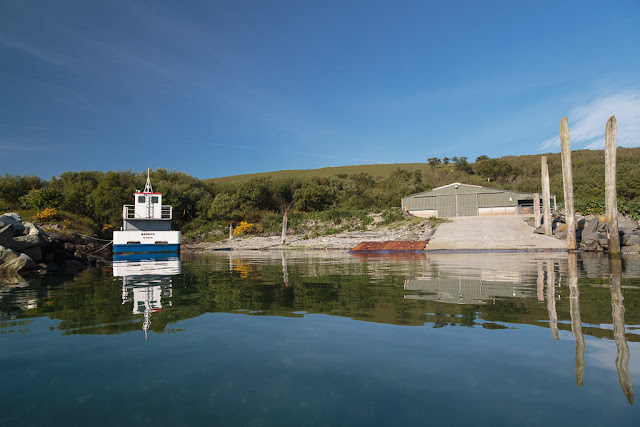We set off down the west coast of Inchmarnock with Holy Island on the horizon and a decent following wind.
At the south end of Inchmarnock we decided to cut across the Sound of Inchmarnock towards...
...Ardscalpsie Point on the island of Bute and then...
...follow the coast round into...
Scalpsie Bay. This was Ian's first time out with his new Flat Earth sail and it was good to try several points of sailing.
In the lee of the land the wind dropped a bit but Ian was already fully at home with his new rig.
As we paddled deeper into the shelter of Scalpsie Bay the...
...wind steadily dropped away and our eyes turned to the shore where...
...the resident seal colony was pretty well camouflaged.
At the head of Scalpsie Bay there is a large expanse of reddish sand. A series of wooden posts in the sand were part of WW2 defences against landing gliders. Beyond the bay lie the fertile fields of Scalpsie farm.
Imagine you are at the edge of the sea on a day when it is difficult to say where the land ends and the sea begins and where the sea ends and the sky begins. Sea kayaking lets you explore these and your own boundaries and broadens your horizons. Sea kayaking is the new mountaineering.
Showing posts with label Inchmarnock. Show all posts
Showing posts with label Inchmarnock. Show all posts
Friday, September 18, 2015
Thursday, September 17, 2015
Our spirits rose with the sun and the wind.
After a comfortable night's camp we rose before dawn to find clouds of midges swarming round the tent vents. Once down on the beach a gentle NW wind was just enough to keep the worst of the midges at bay.
We quickly brewed some warming tea and...
...porridge but despite it being the height of the Scottish "summer" it was bitterly cold.
Fortunately as the sun rose so did the temperature and our spirits.
The wind also began to rise as we carried our kaks through the narrow gap in the reef to the sea. As our eyes turned up the Sound of Bute to the NW....
...it looked like the forecast F4 wind might shortly arrive and it would be going our way. It was time for some paddle sailing!
We quickly brewed some warming tea and...
...porridge but despite it being the height of the Scottish "summer" it was bitterly cold.
Fortunately as the sun rose so did the temperature and our spirits.
The wind also began to rise as we carried our kaks through the narrow gap in the reef to the sea. As our eyes turned up the Sound of Bute to the NW....
...it looked like the forecast F4 wind might shortly arrive and it would be going our way. It was time for some paddle sailing!
Friday, August 28, 2015
Fire at sunset by the Sound of Bute.
Once we had got the kayaks up above where we expected high water to be we unloaded our bags just as...
...the sun was setting.
A few midges came out as we were putting the tents up but fortunately the breeze increased just enough to stop them flying.
There was no sign of the fire Mike and I had made back in June and we set a new fire in the same place. It was nice having the heat of the fire while preparing our evening meal.
It was not just the fire that was glowing. Long after sunset the sky was too!
We decided that our new Helinox chairs were a fabulous addition to any camp fire!
Once the fire was well lit and...
...there were plenty embers we put the tatties in to bake.
...the sun was setting.
A few midges came out as we were putting the tents up but fortunately the breeze increased just enough to stop them flying.
There was no sign of the fire Mike and I had made back in June and we set a new fire in the same place. It was nice having the heat of the fire while preparing our evening meal.
It was not just the fire that was glowing. Long after sunset the sky was too!
We decided that our new Helinox chairs were a fabulous addition to any camp fire!
Once the fire was well lit and...
...there were plenty embers we put the tatties in to bake.
We enjoyed our perfect baked potatoes in the twilight. The only sign of human activity was the Holy Island outer light and lights from a couple of fishing boats plying the Sound of Bute. All this, companionable conversation and no midges, we were certainly in heaven!
Wednesday, August 26, 2015
An atmospheric crossing to Inchmarnock with a sighting of a fire rainbow.
At 6pm we landed for a second luncheon on a little shingle bay to the north of Garroch Head. We had paddled to this point in shorts and tee shirts. We put our salopettes on, not because it was cold (it wasn't) but because we knew we would arrive at our destination on Inchmarnock about sunset and that is when the midges come out!
As we restored energy levels with a snack and a hot drink we enjoyed the most spectacular view across to Glen Sannox on Arran.
Back on the water we had an 11km crossing to our destination of Inchmarnock. We passed Dunagoil Hill which is topped by an Iron Age hill fort.
As we crossed Scalpsie Bay clouds began to gather but the horizon to the west was clear, promising a fine sunset.
A little breeze got up as we passed...
...the fertile fields of Scalpsie farm on Bute which contrasted...
...with the rocky granite ridges of the Arran mountains on the other side of the Sound of Bute.
The sun was lowering towards the horizon as we...
...approached the south end of Inchmarnock. High in the sky we spotted cloud iridescence...
...which is not a commonly seen atmospheric effect. This is also known as a "fire rainbow" or a "rainbow cloud," It usually occurs in late afternoon on hot humid days.
The west coast of Bute is not easy to land on as at low tide there are a series of rocky reefs. It was near spring low water but we knew of a tiny gap in the reefs (about 8m wide). We arrived just after 8pm. This gully can be very difficult to launch from if there is any west in the wind. There are easier beaches at the south and north of the island. Although we had feared a midge attack we were pleasantly surprised that a little NW breeze stopped them flying.
As we restored energy levels with a snack and a hot drink we enjoyed the most spectacular view across to Glen Sannox on Arran.
Back on the water we had an 11km crossing to our destination of Inchmarnock. We passed Dunagoil Hill which is topped by an Iron Age hill fort.
As we crossed Scalpsie Bay clouds began to gather but the horizon to the west was clear, promising a fine sunset.
A little breeze got up as we passed...
...the fertile fields of Scalpsie farm on Bute which contrasted...
...with the rocky granite ridges of the Arran mountains on the other side of the Sound of Bute.
The sun was lowering towards the horizon as we...
...approached the south end of Inchmarnock. High in the sky we spotted cloud iridescence...
...which is not a commonly seen atmospheric effect. This is also known as a "fire rainbow" or a "rainbow cloud," It usually occurs in late afternoon on hot humid days.
The west coast of Bute is not easy to land on as at low tide there are a series of rocky reefs. It was near spring low water but we knew of a tiny gap in the reefs (about 8m wide). We arrived just after 8pm. This gully can be very difficult to launch from if there is any west in the wind. There are easier beaches at the south and north of the island. Although we had feared a midge attack we were pleasantly surprised that a little NW breeze stopped them flying.
Friday, August 21, 2015
Inchmarnock to the West Kyle.
We left the lovely but low lying isle of Inchmarnock floating on a wide expanse of limpid sea. It was...
...dwarfed by the high mountains of Arran on the far side of the Sound of Bute.
Our passage across the Sound of Inchmarnock was accompanied by a black throated diver which flew round and round us until it lost interest as we...
...entered the narrowing...
...confines of the...
...West Kyle of Bute.
We took a last look back at Inchmarnock before the last stage of our journey, which would take us on a winding route deep into the mountains where there would be no sign of an open horizon.
...dwarfed by the high mountains of Arran on the far side of the Sound of Bute.
Our passage across the Sound of Inchmarnock was accompanied by a black throated diver which flew round and round us until it lost interest as we...
...entered the narrowing...
...confines of the...
...West Kyle of Bute.
Thursday, August 20, 2015
Seals and boats on the east coast of Inchmarnock.
On the shore below Midpark lie the sad remains of the wooden ferry MV Dhuirnish. The Dhuirnish was built as a turntable ferry in 1956 for J & A Gardner Ltd. who operated the Taynuilt/Bonawe route across Loch Etive until the service closed in 1966. In 1967 the Bute Ferry Co. Ltd. bought her, removed the turntable and fitted a bow ramp. They operated her on the Colintraive/Rhubodach crossing in the Kyles of Bute where she carried six cars at a time. During the Great Storm on the 14th January 1968 she sank at her mooring in Colintraive. She was raised and re-entered.service the following summer. She remained on the crossing until June 1971. By September 1971 she had had two further owners but it is not known how she ended up on Inchmarnock.
Further north we came to the modern farm buildings and slipway at Northpark where the MV Marnock was moored. She was built on Bute in 1999 for the Inchmarnock Estate who...
...rear a pedigree herd of Highland cattle here.
It was now too hot for our dry suits so we landed near the north of Inchmarnock to disrobe.
No sooner had we landed than an inquisitive group of about 30 common seals surrounded us.
The water looked so inviting that I joined them for a quick swim.
This fellow was not for moving, despite the interest shown by his fellow members of the Welcome to Inchmarnock committee.
Feeling much cooler we continued on our way towards...
...the north of the island where...
...a large rocky spit makes a good place to land to explore the north of the island. It was near here where the stone cist containing the 4,000 year old remains of the "Queen of the Inch" were found.





















































